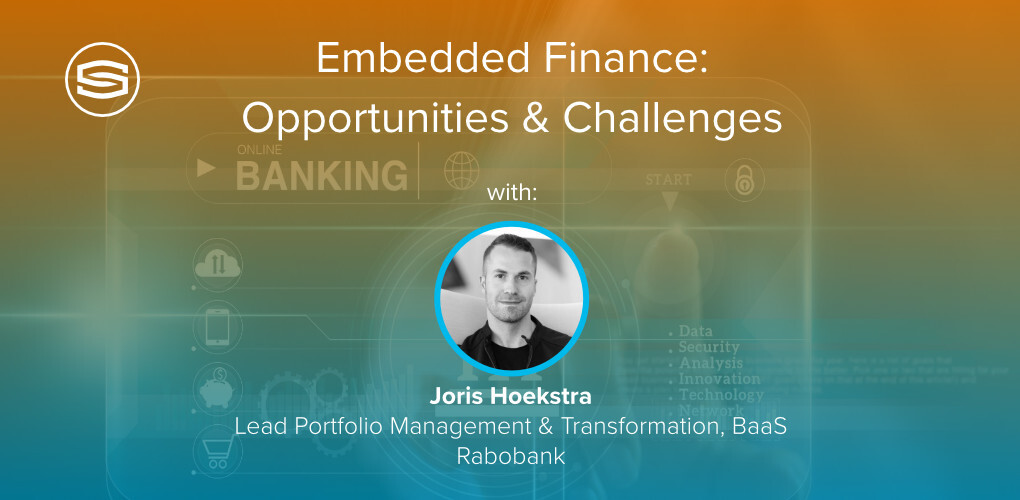
Insights & Opinions
Embedded Finance: Opportunities and Challenges - An Interview with Joris Hoekstra, Lead Portfolio Management & Transformation BaaS, Rabobank
Mon, 30 Oct 2023


After the interview with experts from OpenPayd and ABN AMRO, you know that embedded finance can enable a wide variety of business opportunities, and the future potential is often unknown to business customers.
Continuing with our series of embedded finance interviews, we spoke to Joris Hoekstra, Lead of Portfolio Management and Transformation, to find out how they are approaching the problem. Joris is leading the team responsible for strategy and transformation consulting and portfolio management for Banking-as-a-Service within Rabobank.
It’s all about being there where our clients are, on the platforms that our clients love, in the moments that matter to them.
How would you define embedded finance?
For me, embedded finance is offering financial services into non-banking client journeys, sometimes even without redirecting to the bank or financial institution. It’s all about being there where our clients are, on the platforms that our clients love, in the moments that matter to them.
What are the focus points of Rabobank in the embedded finance space?
Currently, most of the products we offer are payment products, as the open banking revolution started with PSD2, I suppose that is not a surprise. However, we do offer a wide range of risk and identity services as well, for example, for identifying yourself as a client or signing contracts. We also offer some embedded finance and lending products. One of them is Credit Estimate, the assessment of creditworthiness of business clients based on transaction data and chamber of commerce data. Next to that, we offer, for example, invoice financing. Based on your outstanding invoices, you can request a loan, on the platform of your choice.
Back in 2019, I spoke to Nico Strauss and Tjeerd Tesseleer about Rabobank's approach to API developments in the field of open banking. Today, the focus is much more on embedded finance, which goes well beyond the initial open banking offering, isn’t it? What is the situation at Rabobank right now?
Since 2019, we made huge progress. In less than two years, we doubled the number of end users and the number of API calls has increased fivefold. The embedded proposition is now an integral part and key focal point of our business clients strategy. This year one of our mass marketing campaigns was dedicated to Rabo Embedded Services and we were very present at Money2020. Many colleagues are now aware of our Rabo Embedded Services proposition and understand that cross-Rabobank collaboration is required to strengthen and grow our portfolio. If you look at our Rabo Developer Portal and our Embedded Services website, you see a wide range of products, mainly payments, identity and embedded lending.
Currently we are investigating what other products are relevant for our clients to distribute via third party platforms and to bring to the Developer Portal. Think about insurance, housing, consumer finance or sustainability propositions. We also assess in-house capabilities that could be relevant to offer as a service.
Like in every innovation track, some of the ideas will get through, and we will be offering them as propositions in the future. And some of them will not make it, because the business case or client appetite is not strong enough. But then we learn from it and use these insights for future product development.
What also changed is that we have a steering committee now in place across Rabobank, with technology, architecture, several product areas, and sales involved. With this steering committee, we try to solve some cross-organisational impediments, or we try to put in place enablers for optimal client experiences and sustainable growth of our embedded proposition.
One of the challenges, for example, is that we developed products in different ways because we are a big organisation, and also to have short time-to-market. For now, this is not a problem, but in the future, to be able to scale and enable seamless integration for our clients and partners, we need to have more harmonisation and standardisation. And for the future we would like that our products are created in such a way within Rabobank that they are channel agnostic, meaning suitable for both our embedded services channel and our ‘normal’ channels. These are the kinds of topics that we are working on.
So does that mean that the ultimate ambition is to have embedded finance as another channel, like mobile banking and internet banking?
I can imagine that some of the products are more suitable for our embedded channel than others. We work together with product owners across Rabobank and support deliberate distribution choices, taking into account changing client’s needs, market developments and relevant ecosystems.
Back then, Nico told us: “It is more than just setting the tech stack live. The internal culture, the way you organise and the strategy that you roll out with, and the go-to-market are important drivers. You need to go to market to more personas than you did in the past — it’s not only the end customer but also the ecosystem around that customer and the developers themselves as a new persona.”
On one hand, I can imagine that this is a skill that Rabobank has under control now. On the other hand, I can imagine this is a constantly evolving challenge. What is your take on that?
I think we've made some really good steps. But there’s still a way to go, to be honest. Creating an excellent end-to-end developer experience is, for example, very important for us. But for a lot of people the developer is a completely new persona that was not taken into account in ‘traditional’ banking. That requires a different mindset.
We want to work on and improve the journey of all our API consumers, which could be CEOs, financial people, developers, etcetera. It's not only about the Rabobank-client interaction, it’s a whole ecosystem, and we need to make people aware of what that means in terms of collaborating with partners, having other business and pricing models, and so on.
What's the process to become a supplier, the one consuming the APIs using Rabobank's embedded finance offering and how is it different if it is from the open banking developer portal?
We have, in fact, two types of API consumers. On the one hand we have our corporate clients using our APIs. On the other hand we have our partners. For example, bookkeeping parties or other partners that embed our products and services in their platforms and offer them to their clients. They are able to add value to their clients and create stickiness. Their clients benefit from being able to do their business on their preferred platform. And we are able to stay connected with our clients. A triple win situation.
Coming back to your question: within B2B services, our tribe, we have a partner management team in place. If you want to become a partner, our partner managers take care of the onboarding, including pricing agreement and a partnership contract.
Based on that contract, collaboration will start, and it really depends on the type of partnership, the type of products and the type of end users how that partnership looks like. It's very tailored and not one-size-fits-all.
Is the additional ownership that you give to other parties in the embedded finance model something you consider a big challenge for an incumbent bank in that space? Or is it just part of the negotiation process that you just explained?
I see your point. We have to get used to sort of sharing client ownership with the API integrator. That might be a bit scary or at least something new. However, we do know that third-party platforms and ecosystem collaborations are growing and growing. Collaborating with other parties in the ecosystem is important for us to keep our client relationships. My position is that it’s an opportunity. By offering a wide range of products and services in the platforms our clients love and in the journeys they find relevant, I think we are able to further strengthen the client relationship.
This is a new way of doing business. These new business models require cross-organisation and cross-ecosystem collaboration, understanding what’s happening in the market, having an innovative mindset and having another risk appetite.
In our LinkedIn community, Innovation in Payments, I asked for the biggest pitfall in offering embedded finance, and 55% responded with compliance and 23% with technology. What will be your answer? And to what extent can you relate to the feedback I got from the community?
I think technically, quite everything is possible, but of course the business case has to be strong enough. The compliance challenge I recognise more. Another challenge I would rather emphasise is change. We shouldn’t forget that for a lot of people this is a new way of doing business. These new business models require cross-organisation and cross-ecosystem collaboration, understanding what’s happening in the market, having an innovative mindset and having another risk appetite. And also sometimes letting go of what we are used to. That requires serious attention and space for experimenting and failing.
Recently, Roland Berger published a report stating that the biggest concerns in embedded finance for consumers are data security (61%), transparency about services, conditions, and pricing (42%) and trust in the company's security, and stability (33%). Does it sound familiar to you? And more importantly, does it make sense? Or is it the wrong perception by consumers?
Consumer perception is never wrong. If consumers really experience it, or they perceive it this way, then we have to act. It is fundamental that we are very clear about what happens with data, about what consent consumers give, for how long, for what exactly and that we really create as much simplicity and transparency as possible. So I do recognise the concerns and I think we have to work together to overcome this hurdle for clients to start using APIs and embedded finance propositions.
I strongly believe embedded finance will bring great opportunities in the future.
One last question. What makes your positioning so different from the many others who are discovering embedded finance these days?
We are one of the incumbent banks and also one of the biggest banks, with the biggest client base in The Netherlands, with a wide range of financial products and services. As a trusted brand, that enables us to create strong strategic partnerships and it also enables us to offer relevant products and services in relevant client journeys and relevant platforms. There are many things we are working on, but I strongly believe embedded finance will bring great opportunities in the future.